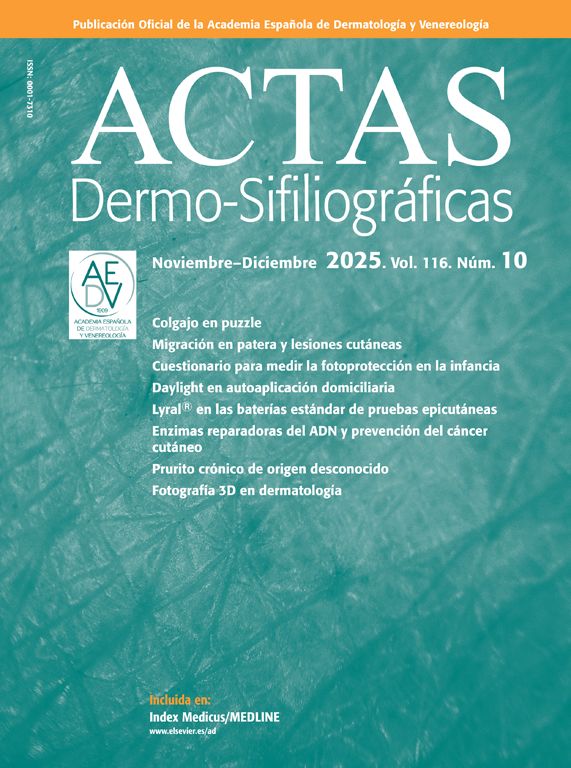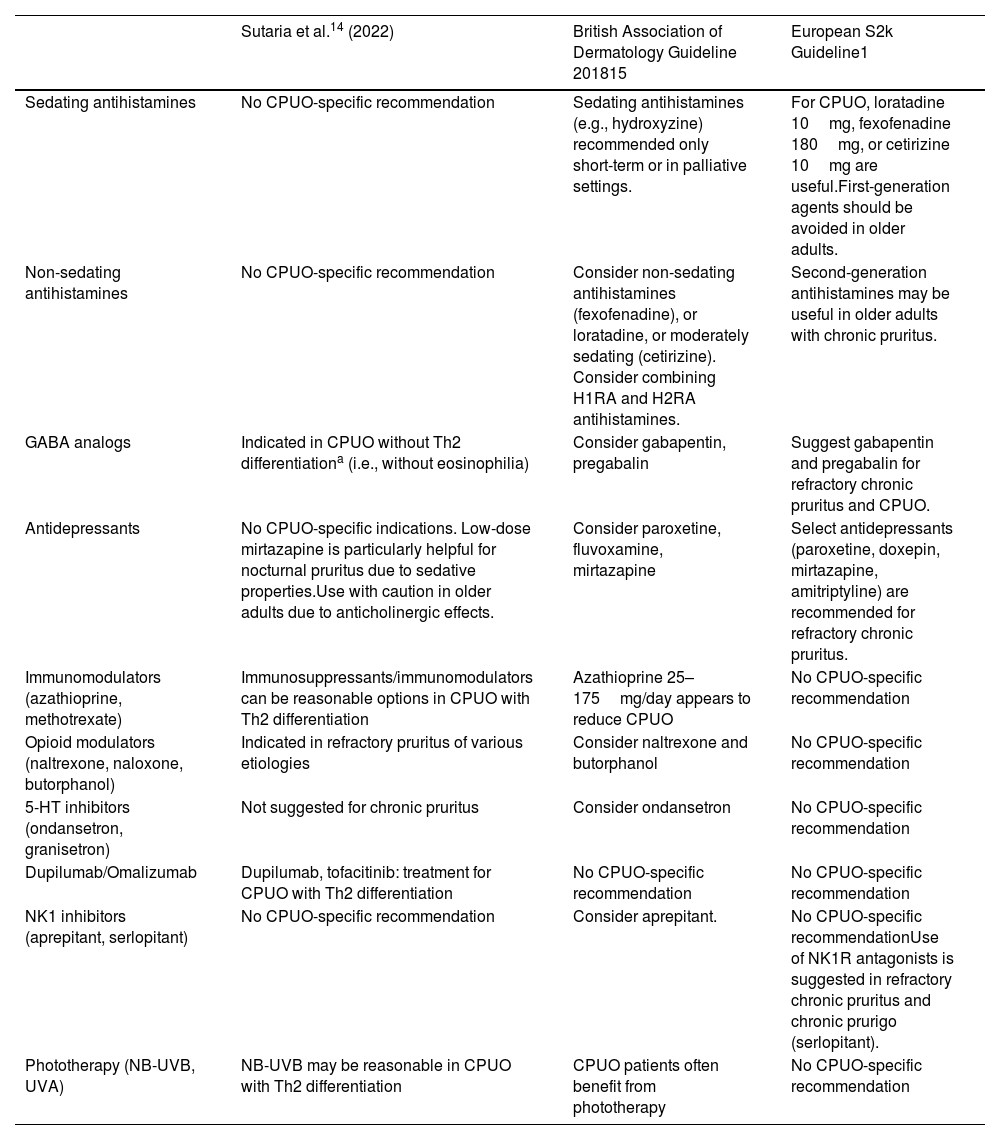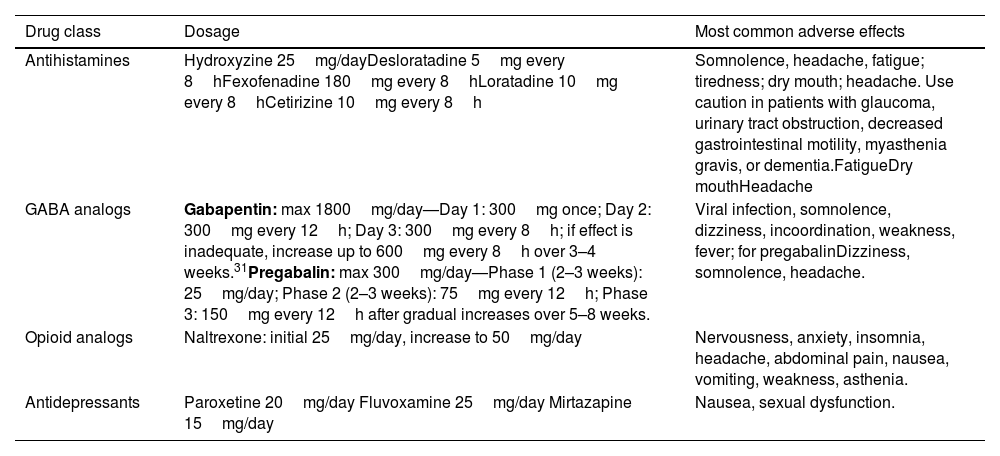Chronic pruritus—itch persisting for more than 6 weeks—has a wide range of dermatologic and systemic causes that can be identified or excluded by following recommended diagnostic pathways for patients with chronic pruritus.1 However, some patients have chronic pruritus in whom no specific cause can be identified; these patients fall under the concept of chronic pruritus of unknown origin (CPUO). Its prevalence is estimated at 6–15% of all people with pruritus.2
Chronic pruritus of unknown origin: concept and clinical featuresCPUO refers to a clinical form of pruritus lasting longer than 6 weeks in which no underlying medical, dermatologic, or systemic cause has been identified to explain it.3 It is therefore a diagnosis of exclusion that should be considered only after a comprehensive evaluation to identify known causes of chronic pruritus (Table 1).
Ancillary studies for identifying chronic pruritus of unknown origin (CPUO).
| General history | No evidence of systemic/neurologic/psychiatric disease or symptoms/signs suggesting themNo evidence of neoplastic disease or symptoms/signs suggesting itaNo evidence of infectious/contagious disease or symptoms/signs/epidemiologic setting suggesting itNo evidence of dermatologic disease or symptoms/signs suggesting itNo use of drugs or other toxins that could be related to pruritusbNo clear trigger identifiedNot pregnant |
| Physical examination | No primary skin lesionsc, no dermatographism, no signs of atopyNo lymphadenopathy or splenomegalyNo stigmata of liver diseaseNormal skin/mucosal color not suggestive of other abnormalities (e.g., anemia, hyperbilirubinemia) |
| Ancillary tests | Normal results on:• Complete blood count with iron studies• Chemistry with liver and renal panels• Thyroid and parathyroid hormones• Glycated hemoglobin• Erythrocyte sedimentation rate• C-reactive protein• Sodium and potassium• Vitamins (D, B12)• Serologies (hepatitis B virus, hepatitis C virus, and human immunodeficiency virus)• Immunoglobulins (total IgE)• Chest radiograph• Stool ova and parasites• Fecal occult blood test in persons>40 years |
If suspected: whole-body contrast CT, craniospinal MRI, peripheral blood smear. Consider these tests in older CPUO patients with repeatedly normal standard studies.
The concept of CPUO was introduced by the International Forum for the Study of Itch to clarify this clinical presentation, unify nomenclature, and abandon earlier terms that created confusion.3,4 Terms such as “generalized pruritus of unknown origin,” “pruritus sine materia,” or “senile pruritus” should be avoided because the symptom is not always generalized, it may be accompanied by secondary dermatologic lesions—or even primary lesions without relevant histopathology—and a substantial proportion of patients are not elderly.4
Regarding “senile pruritus,” CPUO is often conflated with, or used interchangeably for, pruritus in older adults, and many publications include senile pruritus as a form of CPUO. Although chronic pruritus is more prevalent in older patients and, in most cases, pruritus in the elderly ultimately proves to be CPUO (because no underlying etiology is identified),4 age should not be a criterion for diagnosing CPUO. CPUO is observed in younger patients as well; in some series, nearly 70% of patients are younger than 65 years.2,5,6
Clinical profile of the patient with CPUOBy definition, CPUO patients will not have dermatologic lesions or local/systemic symptoms pointing to a primary dermatosis or underlying disease.
However, such patients may show eosinophilia, mildly elevated IgE (<1000IU/mL), dermal hypersensitivity or a spongiotic dermatitis pattern with dermal eosinophils on skin biopsy, and clinically, small pink “micropapules” with generalized distribution.4,7,8 These features, however, are not required to diagnose CPUO.4
From a clinical-analytic perspective, CPUO can be categorized into 2 subgroups with potential therapeutic implications9–12:
- •
CPUO with peripheral eosinophilia. Peripheral blood eosinophilia has been observed in up to 40% of patients with chronic pruritus. These patients tend to be older than those without eosinophilia. The pathogenic mechanism seems more immunomediated with a Th2 phenotype, suggesting a better therapeutic response to immunomodulators.9–12
- •
CPUO without peripheral eosinophilia. These patients often have a history of neurologic or psychiatric disease, which may indicate an itch etiology related more to sensitization of nerve fibers. This subgroup is presumed to respond better to treatments such as gabapentin or pregabalin.9–12
In a German series of 263 patients, CPUO had a duration>1 year in most cases (78%), with daily pruritus (68%) and “attacks” or flares of itch (73%); dysesthesias such as burning, tingling, or stinging were also frequent.2
TreatmentTreating CPUO is challenging primarily because, by definition, its causes and pathogenic mechanisms are uncertain. There are currently no drugs specifically approved for CPUO.13 Recommended regimens are supported by moderate-to-low levels of evidence derived from case reports, case series, and clinical trials of limited quality. Moreover, not all clinical practice guidelines on the management of chronic-pruritus provide CPUO-specific recommendations (Table 2).
Therapeutic recommendations from guidelines/reviews that include CPUO-specific treatment.
| Sutaria et al.14 (2022) | British Association of Dermatology Guideline 201815 | European S2k Guideline1 | |
|---|---|---|---|
| Sedating antihistamines | No CPUO-specific recommendation | Sedating antihistamines (e.g., hydroxyzine) recommended only short-term or in palliative settings. | For CPUO, loratadine 10mg, fexofenadine 180mg, or cetirizine 10mg are useful.First-generation agents should be avoided in older adults. |
| Non-sedating antihistamines | No CPUO-specific recommendation | Consider non-sedating antihistamines (fexofenadine), or loratadine, or moderately sedating (cetirizine). Consider combining H1RA and H2RA antihistamines. | Second-generation antihistamines may be useful in older adults with chronic pruritus. |
| GABA analogs | Indicated in CPUO without Th2 differentiationa (i.e., without eosinophilia) | Consider gabapentin, pregabalin | Suggest gabapentin and pregabalin for refractory chronic pruritus and CPUO. |
| Antidepressants | No CPUO-specific indications. Low-dose mirtazapine is particularly helpful for nocturnal pruritus due to sedative properties.Use with caution in older adults due to anticholinergic effects. | Consider paroxetine, fluvoxamine, mirtazapine | Select antidepressants (paroxetine, doxepin, mirtazapine, amitriptyline) are recommended for refractory chronic pruritus. |
| Immunomodulators (azathioprine, methotrexate) | Immunosuppressants/immunomodulators can be reasonable options in CPUO with Th2 differentiation | Azathioprine 25–175mg/day appears to reduce CPUO | No CPUO-specific recommendation |
| Opioid modulators (naltrexone, naloxone, butorphanol) | Indicated in refractory pruritus of various etiologies | Consider naltrexone and butorphanol | No CPUO-specific recommendation |
| 5-HT inhibitors (ondansetron, granisetron) | Not suggested for chronic pruritus | Consider ondansetron | No CPUO-specific recommendation |
| Dupilumab/Omalizumab | Dupilumab, tofacitinib: treatment for CPUO with Th2 differentiation | No CPUO-specific recommendation | No CPUO-specific recommendation |
| NK1 inhibitors (aprepitant, serlopitant) | No CPUO-specific recommendation | Consider aprepitant. | No CPUO-specific recommendationUse of NK1R antagonists is suggested in refractory chronic pruritus and chronic prurigo (serlopitant). |
| Phototherapy (NB-UVB, UVA) | NB-UVB may be reasonable in CPUO with Th2 differentiation | CPUO patients often benefit from phototherapy | No CPUO-specific recommendation |
H1RA, histamine H1-receptor antagonists; H2RA, histamine H2-receptor antagonists; SSRIs, selective serotonin reuptake inhibitors; CPUO, chronic pruritus of unknown origin; NB-UVB, narrowband ultraviolet B.
The pruritus profile in patients with CPUO—often generalized, without primary skin lesions, and with nocturnal flares—will, in most cases, require systemic therapy. Table 2 outlines the recommendations issued by clinical guidelines for each therapeutic option evaluated in patients with CPUO. The recommendations include limited use of antihistamines, as well as γ-aminobutyric acid (GABA) analogs, opioid-receptor modulators, and antidepressants as key pillars of CPUO management. These should be accompanied by hygienic–dietary measures and topical care to maintain skin integrity.
AntihistaminesAntihistamines have limited efficacy for chronic pruritus because most causes generate persistent itch through non-histaminergic pathways.8 Moreover, there are no high-quality clinical trials evaluating antihistamines specifically in patients with CPUO.16 Even so, given the uncertain pathophysiology of CPUO, the continued inclusion of antihistamines in chronic-pruritus guidelines, and the limited availability of effective options, a therapeutic trial with antihistamines is still reasonable as first-line therapy—especially in patients who have not yet received an adequate regimen (dose and schedule). Decision-making between sedating and second-/third-generation agents should factor in age, clinical profile, and comorbidities. Sedating antihistamines—particularly hydroxyzine—may be offered to patients with nocturnal flares or sleep disruption, but should be avoided in those at risk for urinary outflow obstruction (e.g., benign prostatic hyperplasia), cognitive disorders (dementia), or in advanced age due to anticholinergic risks (urinary retention, dry mouth, nausea) and potential dementia with prolonged use; when used, they should be limited to short courses.15 Non-sedating (fexofenadine, loratadine, desloratadine) or minimally sedating (cetirizine) antihistamines should be considered first-line in patients with chronic pruritus who are at risk of potentiated anticholinergic effects, especially older adults. Doses may be given once to four times daily over 4–6 weeks to assess response; if beneficial, they may be continued longer term.
γ-Aminobutyric acid (GABA) analogsBenefits of gabapentin and pregabalin in CPUO have been shown in case series and (nonrandomized) clinical trials, respectively.14–19 Accordingly, clinical practice guidelines place GABA analogs among early-line options for CPUO, with moderate-to-low evidence strength (level of evidence 3; strength of recommendation D in the British Association of Dermatology guideline).15
Pregabalin is newer, more potent, and more rapidly absorbed.
The 2 agents are generally well tolerated; common adverse effects are listed in Table 3. Alcohol should be avoided because it augments gabapentinoid effects and increases the risk of serious adverse events. Rarely, gabapentin can cause pancytopenia, cholestasis, drug hypersensitivity syndrome, and dyskinesia.18,19 The 2 drugs should be started with controlled titration schedules (Table 3) and tapered off gradually. They are given in divided doses across the day, with one dose at bedtime to improve tolerability and target nocturnal itch exacerbations.
Dosing and most frequent adverse effects of commonly used drugs.
| Drug class | Dosage | Most common adverse effects |
|---|---|---|
| Antihistamines | Hydroxyzine 25mg/dayDesloratadine 5mg every 8hFexofenadine 180mg every 8hLoratadine 10mg every 8hCetirizine 10mg every 8h | Somnolence, headache, fatigue; tiredness; dry mouth; headache. Use caution in patients with glaucoma, urinary tract obstruction, decreased gastrointestinal motility, myasthenia gravis, or dementia.FatigueDry mouthHeadache |
| GABA analogs | Gabapentin: max 1800mg/day—Day 1: 300mg once; Day 2: 300mg every 12h; Day 3: 300mg every 8h; if effect is inadequate, increase up to 600mg every 8h over 3–4 weeks.31Pregabalin: max 300mg/day—Phase 1 (2–3 weeks): 25mg/day; Phase 2 (2–3 weeks): 75mg every 12h; Phase 3: 150mg every 12h after gradual increases over 5–8 weeks. | Viral infection, somnolence, dizziness, incoordination, weakness, fever; for pregabalinDizziness, somnolence, headache. |
| Opioid analogs | Naltrexone: initial 25mg/day, increase to 50mg/day | Nervousness, anxiety, insomnia, headache, abdominal pain, nausea, vomiting, weakness, asthenia. |
| Antidepressants | Paroxetine 20mg/day Fluvoxamine 25mg/day Mirtazapine 15mg/day | Nausea, sexual dysfunction. |
Antidepressants studied for chronic pruritus without mood disorder include selective serotonin reuptake inhibitors (SSRIs: paroxetine, fluvoxamine, citalopram, fluoxetine), serotonin–norepinephrine modulators (mirtazapine), and tricyclics (TCAs: doxepin, amitriptyline). The agent with the strongest evidence is paroxetine 20mg/day for at least 4–6 weeks20; some cases have used up to 40mg/day.8 Fluvoxamine 25mg/day has also shown benefit in CPUO series.21 Mirtazapine may help in some cases,22 particularly when sleep disturbance (nocturnal itch) coexists,16 but overall evidence is limited and recommendations are controversial.20,23,24 SSRIs typically require 2–3 weeks to begin relieving itch, with maximum response at ∼4–6 weeks.1
Adverse effects are common (somnolence, fatigue, headache), especially early. In older adults, SSRIs such as paroxetine can be effective but may increase risks of erectile dysfunction and insomnia (Table 3). TCAs (doxepin, amitriptyline) should be avoided in older adults due to anticholinergic effects.1
ImmunomodulatorsAlthough immunomodulators/immunosuppressants have shown efficacy in CPUO patients with a pronounced Th2 profile,9–12 clinical practice guidelines generally do not recommend them for routine CPUO management (Table 2). Methotrexate has benefited pruritus treatment, particularly in older adults.12 Azathioprine (25–125mg/day) was effective in a large CPUO series but with frequent adverse effects.15,25 Toxicity limits use based on comorbidities, contraindications, and the feasibility of close monitoring. Before starting methotrexate or azathioprine for CPUO, paraneoplastic pruritus should be excluded.
Opioid modulatorsOpioid receptors are key in chronic-pruritus pathophysiology: μ-opioid–receptor (MOR) activation is pro-pruritic, whereas κ-opioid–receptor (KOR) activation is anti-pruritic.26,27 Naltrexone, a MOR antagonist, has the most evidence in CPUO, with favorable results in case series and open trials.26 Typical dosing is 50mg/day,8,26,27 though up to 150mg/day has been used without negative effects. Naltrexone is usually well tolerated; side effects (Table 3) tend to occur within the first 2 weeks. To mitigate these, start low (e.g., 25mg/day) and titrate.
Neurokinin-1 inhibitorsNeurokinin-1 antagonists (aprepitant, serlopitant) have been studied in small series of refractory pruritus of multiple etiologies,14 with modest improvement in a few CPUO patients and contradictory results elsewhere,8,20,28 coupled with high cost. Therefore, current chronic-pruritus guidelines make no recommendations for CPUO.
Monoclonal antibodies and small-molecule inhibitorsEvidence is limited, but biologics have been used for chronic pruritus. Dupilumab—which blocks IL-4/IL-13 receptors—has shown efficacy in CPUO by dampening Th2-mediated inflammation, though some patients require prolonged time to benefit (mean ∼19 months).7,13,29 Tofacitinib, a JAK1 kinase inhibitor and Th2-differentiation modulator, has also reduced itch in this profile.14 Nonetheless, chronic-pruritus guidelines do not currently recommend monoclonal antibodies for pruritus of causes other than chronic urticaria or atopic dermatitis (Table 2).1
PhototherapyUse of narrowband UVB (NB-UVB) for generalized pruritus of unknown cause is controversial,30 and most guidelines—except the British guideline—do not issue recommendations for CPUO.1,14,15 The British guideline suggests CPUO patients often benefit from UV therapy, albeit with a low recommendation grade (Table 2).
Therapeutic algorithm for CPUOBased on guideline recommendations—recognizing the moderate-to-low evidence supporting them—Figure 1 outlines a practical decision algorithm. Recommended dosing and common adverse effects appear in Table 3.
After classifying the presentation as CPUO (Table 1) and documenting prior therapies, comorbidities, and contraindications, if the patient has not had an adequate antihistamine trial, initiate one (Fig. 1). In younger patients with sleep disruption from itch, nighttime hydroxyzine may be considered. If effective, discontinue the sedating antihistamine after 4–6 weeks; non-sedating antihistamines may be continued longer if beneficial. As second-line therapy in those resistant to antihistamines, start a GABA analog—preferably pregabalin first; if ineffective or contraindicated, try gabapentin. If GABA analogs are contraindicated or ineffective, consider paroxetine based on patient profile, or start naltrexone directly. Although evidence for phototherapy in CPUO is limited, its favorable safety profile supports use even in older adults, especially NB-UVB. If these options fail—and in patients with findings suggestive of a Th2 profile—a therapeutic trial of immunomodulators (methotrexate, azathioprine, systemic corticosteroids) may be considered (Fig. 1). In conclusion:
- •
Avoid diagnosing CPUO when the pruritus can be explained by another mechanism.
- •
Use the CPUO diagnosis only after completing thorough physical examination and baseline/targeted tests based on suspicion (Table 1).
- •
CPUO usually requires systemic treatment.
- •
In patients without sustained benefit from non-sedating antihistamines, discontinue them and escalate therapy.
- •
All systemic drugs used for CPUO are off label and require usual institutional approvals; patients must be informed and adverse effects documented in the record.
Proposed therapeutic algorithm for patients with chronic pruritus of unknown origin. * Every 6–8h for at least 4–6 weeks. CKD, chronic kidney disease; COPD, chronic obstructive pulmonary disease; BPH, benign prostatic hyperplasia; SSRIs, selective serotonin reuptake inhibitors; NB-UVB, narrowband ultraviolet B.
Vidal A and Moreno-Ramírez D contributed equally to drafting and preparing this manuscript.
Conflicts of interestNone declared.








